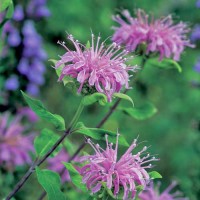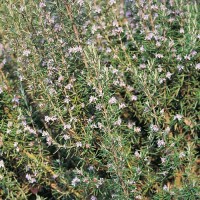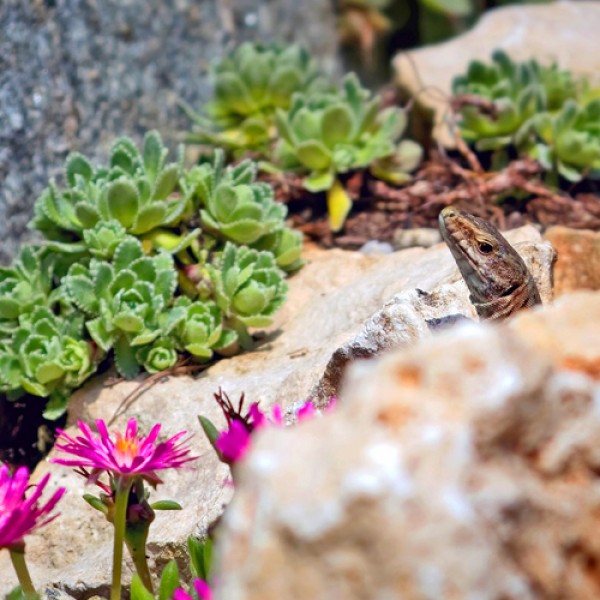The rock garden - bee-friendly
Who doesn`t know it? Gravel gardens on every corner? Why?
People think gravel gardens are easy to care for, but many of them underestimate the actual work involved.
To show a beautiful and also bee-friendly alternative that really makes maintenance easier in the long run, we would like to show the rock garden today. In the beginning, an intensive study of the theme of the rock garden is necessary, or even an expert is needed, but in the long run the rock garden will show its true beauty.
By the way, the rock garden is not cheap - but it is a rewarding purchase in the long-term, which makes it easier for older people to care for.
In terms of appearance, the rock garden is based on the idea of an Alpine landscape in miniature. Every climbing or alpine enthusiast`s heart beats faster when they see a wonderfully designed rock garden, or even have one in their own home.
The creation of a new rock garden
The following should be taken into account:
- Rock garden plants are sun lovers who want sunlight all day long.
- uneven parts of the garden, slopes or roadsides where there are differences in height are particularly suitable.
- The ideal substrate for a rock garden is a soil with a high sand content; if the soil has little sand, it should be mixed in.
What else you need before you start working:
- a scaled sketch of the garden area for the rock garden
- note the light level and light pattern on the sketch, for the right selection of plants
- record the soil texture n and mark places that need repair. A rock garden should never be planted in places where there is permanent waterlogging.
- Information on the different types of stone used and the cost of these should be obtained and noted down.
- Plant information should be obtained
Which stones are best for a rock garden?
Basic questions to ask yourself beforehand:
- How do you want to create the rock garden?
- What is the idea behind the design?
- Which region is the rock garden based on?
- Which stones are native to the region?
- Which stones do you prefer and are still ideal for the garden?
- How expensive are the stones? Where can they be obtained?
Basic requirements for the stones:
- they should not deteriorate too quickly
- Very soft stones (limestone, dolomite, etc.) should be supplemented with sandstone or slate, or hard stones such as granite.
- the stones should be easy to plant and ideally have a structure with some holes in it
- it is best to choose regional types of stone
Natural stones are suitable for different purposes, such as walls, but pebbles are better for other types, such as a fountain base.
Stones for a wide stone wall without mortar with planting are:
Limestone, slate, greywacke or sandstone (here it is best to use stones from the region) in order to be as close to nature as possible.
Rock garden with slope:
A large rock boulder as an eye-catcher, a natural stone stream supplemented with sandstone, limestone, pebbles or slate.
A rock garden like in the Alps:
Large boulders as an eye-catcher or to support the slope, solid stone steps to walk on, Alpine limestone, granite.
A Mediterranean rock garden:
Limestone, sandstone, large sandstones (boulders) as slope support or as an eye-catcher.
DIY - How to create a rock garden :
1. marking the place for the rock garden in accordance with the sketch made beforehand.
2. Dig the soil to a depth of 30 - 50 cm over the whole area to be used for the rock garden.
3. remove all weeds and roots from the Ground
4. if a railing is wanted, it must be filled in with soil
5. lay out a wire to cover the area.
6. a 20-30 cm layer of gravel, sand, rubble and soil mixture is piled up as a drainage layer. This layer can also be provided with small hills if necessary.
7. cover the drainage layer with weed fleece, the places where the fleece overlaps should be at least 10 cm Long.
8. spread a mixture of sand and gravel or a suitable soil mixture from a specialist shop.
9. store the stones outside the rock garden area, preferably in order of size.
10. spread the larger boulders over the rock garden area and partially dig them into the soil
11. fill in the spaces between the boulders with smaller natural stones and chippings
12. the correct decoration will follow after planting the chosen plants
13. select the plants in accordance with the location and place them in the right places.
14. when all the plants have been placed, move the stones to the side and insert the plants.
15. water all the plants a little to make it easier for them to grow, but be careful! Please do not water too much, as most rock garden plants do not like excessive moisture.
16. shape the rock garden with medium-sized stones and fill in any gaps with chippings and smaller natural Stones.
17. if mosses and stone plants are to be placed on the stones, they can be placed in the gaps or holes in the Stones.
If you want water in a rock garden?
If you want to have a stream, pond or something similar in the rock garden, you have to consider this beforehand in the planning.
A stream, for example, requires more preparation and a backflow to ensure that the water does not seep into the ground and flows back into the stream again and again in a cycle.
The different ways to integrate a stream or water into the rock garden?
The pond:
To loosen up the rock garden a little and give it more life, you can plan an area for a garden pond in the rock garden. The size of the desired pond should always be taken into account when planning.
The pond can either be bought as a ready-made pond basin, or you can build your own shape and line it with pond liner (specialist knowledge required).
stream:
A stream in a rock garden always requires some gradient. In most cases it can be beautifully combined with a pond or water basin. If you pay attention to the water cycle, you can integrate a pump in the pond that keeps pumping water into the spring stone in the stream.
There is also the possibility of using prefabricated bowls, which are available in different depths and sizes, or of creating your own stream with the help of pond liner and matching stones.
An old bathtub or tub as a water featureWasserspiel:
If you do not want to integrate a permanent water feature into your rock garden, you can use an old bathtub or tub as a water element in the garden. To make the tub watertight, you can line it with pond liner or use a ready-made pond tub of the right size. To keep the water clean, you can either use a small pump with a water feature or regularly renew the water with the help of a hose. However, it is important to note that standing water always attracts mosquitoes!
Plants for the rock garden:
Sunny place:
Sedum (fat hen), phlox (as a carpet), shrubby medlar, grass carnations (dwarf form), gentian, thyme, dwarf pine, blue cushion, houseleek, roofwort, red spatula fat leaf, sedum, rock flower, civet, woundwort.
rather shade-loving:
Purple bellflower, beautyleaf sparkle, creeping günsel, mosses, ferns, mock berry, bergenia
For planting on a wall or Stones:
Heath günsel, wall pepper, garden snapdragon, sand carnation, catmint, small ferns, mosses
Conclusion:
The rock garden offers a wonderful, low-maintenance alternative to the gravel garden and provides bees with a wonderful opportunity to feed. A natural rock garden is also ideal as a hiding place for small lizards, insects, small mammals and caterpillars.
If you pull small emerging weeds directly from the soil in spring and summer, you only have to work the garden a little. Since the rock garden plants are not demanding, it is sufficient to water them from time to time and to remove dead plant parts.




















